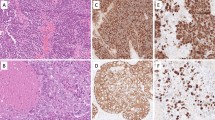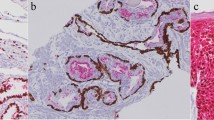Abstract
The clinical significance of the presence or absence of regional variations in histologic differentiation within a primary colorectal carcinoma was investigated in this study. Regional variations in histologic differentiation were judged to be present when the low power field of a microscope was occupied by cancer tissue cytologically and architecturally different from that of the surrounding area. Regional variations in histologic differentiation were noted in 153 (42%) of 368 primary carcinomas. Carcinomas with regional variations were of an anaplastic histologic type and had a higher incidence of lymph node metastasis and a worse prognosis than those without regional variations. Thus, the histologic diversity within a carcinoma is thought to be important for determining the prognosis of patients with colorectal cancer.
Similar content being viewed by others
References
Petersen SE, Bichel P, Lorentzen M (1979) Flow-cytometric demonstration of tumor cell subpopulations with different DNA content in human colorectal carcinoma. Eur J Cancer 15:383–386
Dexter DL, Spremulli EN, Fligiel Z, Barbosa JA, Vogel R, Von Voorhees A, Calabresi P (1981) Heterogeneity of cancer cells from a single human colon carcinoma. Am J Med 71:949–956
Brattain MG, Levine AE, Chakradanty S, Yeoman LC, Willson JKV, Long B (1984) Heterogeneity of human colon carcinoma. Cancer Metastas Rev 3:177–191
Rutzky LP, Siciliano MJ (1982) Various isozyme gene expression patterns among human colorectal adenocarcinoma cell lines and tissues. J Natl Cancer Inst 68:81–90
Rognum TO, Brandtzaeg P, Thorud E (1983) Is heterogeneous expression of HLA-DR antigens and CEA along with DNA-profile variations evidence of phenotypic instability and clonal proliferation in human large bowel carcinoma? Br J Surg 48:543–551
Quirke P, Dyson JED, Dixon MF, Bird CC, Joslin CAF (1985) Heterogeneity of colorectal adenocarcinomas evaluated by flow cytometry and histopathology. Br J Cancer 51:99–106
Hiddeman W, von Bassewitz DB, Kleinemeier HJ, Schulte-Brochterbeck E, Hauss J, Lingemann B, Buchner T, Grundmann E (1986) DNA stemline heterogeneity in colorectal cancer. Cancer 58:258–263
Sasaki K, Hashimoto T, Kawachino K, Takahashi M (1988) Intratumoral regional differences in DNA ploidy of gastrointestinal carcinomas. Cancer 62:2569–2575
Spremulli EN, Scott C, Campbell DE, Libbey NP, Shochat D, Gold D, Dexter DL (1983) Characterization of two metastatic subpopulations originating from a single human colon carcinoma. Cancer Res 43:3828–3835
Siracky J (1979) An approach to the problem of heterogeneity of human tumor-cell populations. Br J Cancer 39:570–577
Leith JT, Dexter DL, DeWyngaert JK, Zeman EM, Chu MY, Calabresi P, Glicksman AS (1982) Differential responses to X-irradiation of subpopulations of two heterogeneous human carcinomas in vitro. Cancer Res 42:2556–2561
Bliven SF, Schneiderman TE, Leith JT (1987) Cell cycle responses of heterogeneous human colon adenocarcinoma subpopulations to X-irradiation. Cell Tissue Kinet 20:473–483
Bresalier RS, Boland CR, Kim YS (1984) Characteristics of colorectal carcinoma cells with high metastatic potential. Gastroenterology 87:115–122
Kimball PM, Brattain MG (1980) Isolation of a cellular subpopulation from a human colonic carcinoma cell line. Cancer Res 40:1574–1578
Japanese Research Society for Cancer of Colon and Rectum (1983) General rules for clinical and pathological studies on cancer of the colon, rectum, and anus. Jpn J Surg 13:557–598
Gastrointestinal Tumor Study Group (1985) Prolongation of the disease-free interval in surgically treated rectal carcinoma. N Engl J Med 314:1465–1472
Sadahiro S, Ohmura T, Saito T, Akatsuka S (1989) An assessment of the mucinous component in carcinoma of the colon and rectum. Cancer 64:1113–1116
Carr I, Levy M, Watson P (1986) The invasive edge: Invasion in colorectal cancer. Clin Expl Metastasis 4:129–139
Watson PH, Carr I (1987) A morphometric study of invasion and metastasis in human colorectal carcinoma. Clin Exp Metastasis 5:311–319
Symonds DA, Vickery ALJ (1979) Mucinous carcinoma of the colon and rectum. Cancer 37:1891–1900
De Mascarel A, Coindre JM, de Mascarel I, Trojani M, Maree D, Hoerni B (1981) The prognostic significance of specific histologic features of carcinoma of the colon and rectum. Surg Gynecol Obstet 153:511–514
Chung CK, Zaino RJ, Stryker JA (1982) Colorectal carcinoma: Evaluation of histologic grade and factors influencing prognosis. J Surg Oncol 21:143–148
Riboli EB, Secco GB, Lapertosa G, DiSomma C, Santi F, Percivale PL (1983) Colorectal cancer: Relationship of histologic grading to disease prognosis. Tumori 69:581–584
Wolly RC, Schriver K, Koss LG, Karas M, Sherman A (1982) DNA distribution in human colon carcinomas and its relationship to clinical behavior. J Natl Cancer Inst 69:15–22
Armitage NC, Robins RA, Evans DF, Baldwin RW, Hardcastle JD (1986) The influence of tumor cell DNA abnormalities on survival in colorectal cancer. Br J Surg 72:828–830
Scott NA, Rainwater LM, Wieand HS, Weiland LH, Pemberton JH, Beart RW Jr, Lieber MM (1987) The relative prognostic value of flow cytometric DNA analysis and conventional clinicopathologic criteria in patients with operable rectal carcinoma. Dis Colon Rectum 30:513–520
Kokal WA, Garden RL, Sheibani K, Morris PL, Prager E, Zak I, Terz JJ (1989) Tumor DNA content in resectable primary colorectal carcinoma. Ann Surg 209:188–193
Meiling IG, Rognum OT, Clausen FO, Chen Y, Lunde OC, Schlichting E, Wiig JN, Hognestad J, Bakka A, Havig O, Bergan A (1990) Association between DNA ploidy pattern and cellular atypia in colorectal carcinomas: A new clinical application of DNA flow cytometric study? Cancer 67:1352–1357
Author information
Authors and Affiliations
Rights and permissions
About this article
Cite this article
Kotanagi, H., Fukuoka, T., Shibata, Y. et al. The clinical significance of regional variations in histologic differentiation within carcinomas of the colorectum. Surg Today 23, 407–411 (1993). https://doi.org/10.1007/BF00309498
Received:
Accepted:
Issue Date:
DOI: https://doi.org/10.1007/BF00309498




